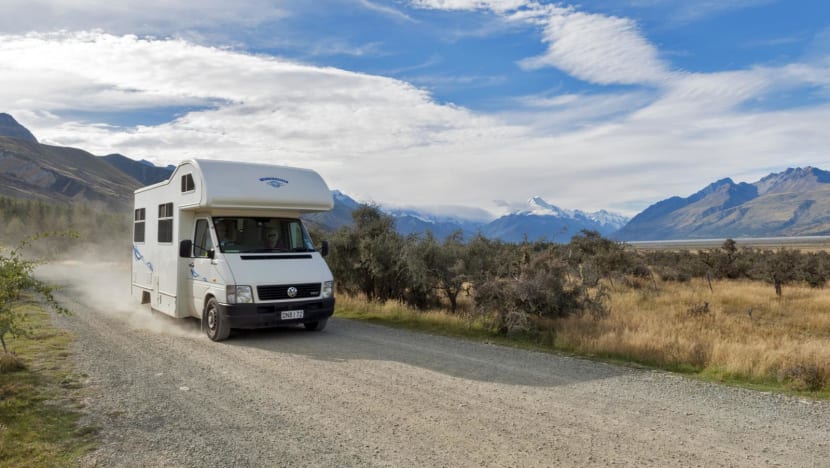New Zealand road safety experts urge caution after campervan accident that killed 3 Singaporeans
Driving on New Zealand's quiet highways through farmland and bush is a completely different experience from driving in Singapore, says a road safety expert.

A motorhome on a gravel road at Mount Cook National Park in New Zealand. (File photo: iStock)
SINGAPORE: New Zealand road safety experts have urged caution on rural roads and highways after an accident that killed three Singaporeans last month.
National University of Singapore undergraduates Sherwin Chong Shi Yun and Xinyue Yang, both 21, and Jia Jun Vincent Lim, 24, died after their campervan collided with a barrier and caught fire.
The accident happened on Apr 17 at the intersection of State Highway 79 and Te Moana Road near the town of Geraldine, about 140km southwest of Christchurch. Police were alerted to the crash just after 1am.
The New Zealand Herald reported that the campervan was rented from a company based in the local Canterbury region.
DRIVING A LARGER VEHICLE
Tourists who hold a “full overseas car licence” can drive any vehicle weighing 6,000kg or less, except motorcycles, according to the New Zealand Transport Agency.
This means that someone with a Singapore car licence – class 3 – can rent and drive a car, campervan or motorhome in New Zealand.
But campervans and motorhomes are much bigger vehicles and need to be driven very differently compared with a car, said Mr Dylan Thomsen, road safety spokesperson for the New Zealand Automobile Association.
“They are slower to accelerate and take longer to slow down and stop. They also turn slower and are more top-heavy so drivers need to take corners (more slowly) and more carefully,” he said.
Drivers of these vehicles should also use their rearview and side mirrors often to check what is behind or around them, he added.
While most highways and motorways in New Zealand have a maximum speed limit of 100 to 110kmh, campervans and motorhomes have a speed limit of 90kmh.
Dr Shane Turner, technical director for road safety at transport specialist firm Abley, advised driving these vehicles at an even slower speed of 80kmh.
Where safe to do so, drivers can stop at pull-off bays at regular intervals to allow cars behind to overtake, he said.
Ideally, inexperienced drivers should pick up their campervans or motorhomes in locations where they can get some driving experience on urban roads, motorways or rural roads with wide shoulders – such as New Zealand's State Highway 1 – before driving on narrower state highways, he added.
Related:
NEW ZEALAND HIGHWAYS
As in Singapore, drivers in New Zealand drive on the left side of the road and road signs use the metric system (kilometres instead of miles). But there are differences in driving in both countries.
“If someone has spent most of their life driving in a busy, dense environment like Singapore, they will find New Zealand’s quiet highways through farmland and bush a completely different experience,” said Mr Thomsen.
Outside New Zealand’s main cities, most highways are two-lane, undivided roads that can look different from highways in other countries, he said.
“Because most of our highways do not have a median barrier separating oncoming traffic, it is vital for tourists to remember that New Zealand is a country that drives on the left and stick to that lane.”
While state highways make up only 12 per cent of New Zealand’s road network, they contribute a third of the vehicle kilometres travelled and more than half of crashes with deaths and serious injuries, said Mr Mark Newsome, principal engineer for road safety at engineering consultancy WSP.
“This means the crash rate (both as a measure of length and as a measure of travel activity) is proportionally higher on state highways than on local roads,” he said.
The state highway network is predominantly rural. The most common crash types on rural roads are head-on crashes, run-off-road collisions or at intersections.
Based on what has been reported about the crash involving the Singaporeans, Dr Turner said it appeared “more typical of a mid-block crash, where a driver has lost control – possibly due to fatigue – which is common at this time of night”.
In that case, the intersection does not seem to have been a key factor in the crash occurring, he said.
“However, there has been a history of high-profile fatal crashes involving tourists at give-way or stop-controlled intersections in New Zealand,” he added.
“My advice at intersections is to be particularly careful and check multiple times when turning or crossing at a give-way or stop-controlled approach that there are no vehicles coming on the main road.”
ADVICE FOR TRAVELLERS
Tourists should avoid driving while tired. "People often arrive after a long flight and get straight into a rental vehicle to begin driving,” said New Zealand Automobile Association's Mr Thomsen.
He advised that travellers stay close to the airport on their first night and ensure they are well-rested before embarking on any long drives.
All three experts pointed out that journeys in New Zealand can take longer than expected and advised travellers to budget extra time.
For example, driving from Auckland to Wellington should take nine to 10 hours if several breaks are taken on the way, said Mr Thomsen. Google Maps estimates the journey at under eight hours.
“If a tourist is driving in remote parts of New Zealand, they may well encounter tractors or even farmers moving animals on a highway, so it’s really important for drivers to be prepared to encounter situations like that and (be) able to slow down or stop quickly,” he added.
Dr Turner advised drivers to keep to the state highway network where possible as it generally has a “higher design standard”, and to avoid gravel roads unless they have experience on such roads.
“Plan ahead and identify if there are sections of gravel roads to negotiate to access a destination. Drive slowly on gravel roads. I would suggest a maximum speed limit of 70kmh.”
He added: “New Zealand roads can be challenging to drive as our roads are narrower, more winding and sometimes steeper than in many other countries.”
He stressed the importance of travelling at speeds that match the conditions, which are often “well below” the default open road speed limit of 100kmh.
“Although speed isn’t always a reason for a crash occurring, it can determine whether someone is killed, injured or walks away unharmed following a crash,” said Mr Newsome.














